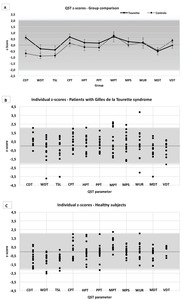Schunke, O;
Grashorn, W;
Kahl, U;
Schoettle, D;
Haggard, P;
Muenchau, A;
Bingel, U;
(2016)
Quantitative Sensory Testing in adults with Tourette syndrome.
Parkinsonism & Related Disorders
, 24
pp. 132-136.
10.1016/j.parkreldis.2016.01.006.

Preview |
Text
Haggard_GTS_QSTFinal_NewWithoutReferenceFieldCodes_Rebuttle_29.10.2015CG_OS_UB_OS_final.pdf - Accepted Version Download (199kB) | Preview |
Preview |
Text
Haggard_Table 1_GTS_QST_Final.pdf - Accepted Version Download (158kB) | Preview |
Preview |
Text
Haggard_Table_QSTParameters_Supplement.pdf - Accepted Version Download (192kB) | Preview |
![[thumbnail of Haggard_grafiken.jpg]](https://discovery.ucl.ac.uk/1479194/25.hassmallThumbnailVersion/Haggard_grafiken.jpg)  Preview |
Image
Haggard_grafiken.jpg - Accepted Version Download (694kB) | Preview |
Abstract
INTRODUCTION: Abnormal sensory perceptions, for instance hypersensitivity to certain external stimuli or premonitory urges preceding tics, are core features in Gilles de la Tourette syndrome (GTS). Aberrant awareness of externally applied stimuli in terms of altered sensory perception thresholds might contribute to these sensory phenomena in GTS. METHODS: We used the well-established and standardized “Quantitative Sensory Testing” (QST) battery (German Research Network on Neuropathic Pain) to investigate 13 sensory parameters including thermal, mechanical/tactile and pain thresholds in 14 GTS patients without clinically significant comorbidities and 14 healthy controls matched for age and gender. RESULTS: There were no relevant group differences in any of the 13 QST parameters and no specific QST pattern in GTS patients. There was no correlation between QST parameters and “Premonitory Urge for Tics scale” (PUTS) scores. CONCLUSION: Our data show that the perceptual threshold detection of externally applied sensory stimuli is normal in adults with GTS. This indicates that other perceptual mechanisms, such as abnormal central sensorimotor processing and/or aberrant interoceptive awareness might underlie the clinically significant sensory abnormalities in GTS.
| Type: | Article |
|---|---|
| Title: | Quantitative Sensory Testing in adults with Tourette syndrome |
| Open access status: | An open access version is available from UCL Discovery |
| DOI: | 10.1016/j.parkreldis.2016.01.006 |
| Publisher version: | http://doi.org/10.1016/j.parkreldis.2016.01.006 |
| Language: | English |
| Additional information: | This version is the author accepted manuscript. For information on re-use, please refer to the publisher’s terms and conditions. |
| Keywords: | Science & Technology, Life Sciences & Biomedicine, Clinical Neurology, Neurosciences & Neurology, Tourette syndrome, Quantitative Sensory Testing, Premonitory sensations, Sensory, Thresholds |
| UCL classification: | UCL UCL > Provost and Vice Provost Offices UCL > Provost and Vice Provost Offices > School of Life and Medical Sciences UCL > Provost and Vice Provost Offices > School of Life and Medical Sciences > Faculty of Brain Sciences UCL > Provost and Vice Provost Offices > School of Life and Medical Sciences > Faculty of Brain Sciences > Div of Psychology and Lang Sciences UCL > Provost and Vice Provost Offices > School of Life and Medical Sciences > Faculty of Brain Sciences > Div of Psychology and Lang Sciences > Institute of Cognitive Neuroscience |
| URI: | https://discovery.ucl.ac.uk/id/eprint/1479194 |
Archive Staff Only
 |
View Item |


